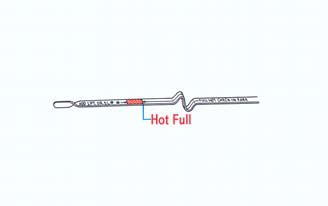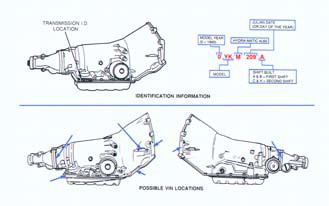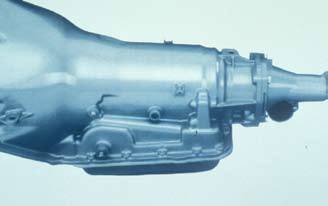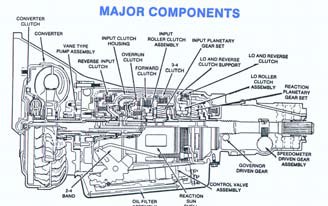If you own a 1984 to 1996 Corvette you probably have an automatic transmission. Most Corvette owners prefer the automatic transmissions to the manual transmission. This means that most of you reading this article have an automatic transmission in your Corvette.
The good part is that very little ever goes wrong with these automatics. These are very solid transmissions and seldom need repair. The most common reason for repair is simple abuse and the most damaging abuse comes from neglect.
Since most of you purchased your C4 Corvette on the used car market there’s a need to check out the transmission. You can make two very simple checks. First, you should check the fluid level. Make sure you do this when the car is completely warmed up. Also, make sure you always check the car with the engine running.
TIME: 1 HOUR
TOOLS: 3/8 INCH DRIVE METRIC SOCKETS
TALENT: ****
TAB: $50
COMPLEMENTARY WORK: If you’re considering the installation of a shift kit in your automatic, keep in mind that you’ll also be changing the fluid and filter at that time.
TIP: Make sure you ask a lot of questions before you let a shop tear into your transmission. The expense is great and a lot of things can happen to your car while it’s in the shop. Make sure you find a top quality shop. The quality of work is going to be a lot more important than final price.
CHECKING THE FLUID LEVEL
This one is supposed to be so easy I shouldn’t even have to write about it. On the other hand, after twenty years in the service business and a few years with a major transmission chain, I have to point out that very few people know how to properly check the level of the automatic transmission fluid. Low fluid levels are a major reason that automatic transmissions have to be repaired.
One last point is that you should never check the fluid immediately after coming off the interstate. High speed driving will give you a false reading on the dipstick, or as GM calls it, the fluid level indicator blade. Wait at least three minutes with the car in Park before you check the fluid level.
You not only need to see that the transmission is properly filled but you also want to get an indication about the condition of the fluid. After you remove the dipstick place it on a white paper towel. The fluid should soak into the towel fairly easily. If the fluid doesn’t readily soak into the paper towel and/or is black in color it’s probably compacted with fiber material which is the first sign of clutch wear.
If you can actually see clutch material on the paper towel then you can be almost certain that the clutches need to be replaced. Just for comparison drop some brand new Dexron III ATF fluid next to the spot being checked. This will give you a good side by side comparison of how drastically your fluid may have changed since it was last serviced.

It’s important to keep track of the fluid level in your transmission. It may sound a little silly if you know what you’re doing, but on the other hand fluid neglect is the single largest cause of transmission failure. Make sure you read the dipstick correctly and that you also check the condition of the fluid at the same time. You really won’t look all that silly with your nose on the dipstick to check for a burning smell. You’ll feel a lot sillier if you have to get a home equity loan to pay for a new transmission in your Corvette.
MAINTENANCE
The only thing you need to do is change the fluid and filter on a regular basis. I’m a fanatic about regular fluid and filter changes for an automatic transmission. I recommend that you change it on an annual basis even though that may be a little excessive.
I will offer one suggestion though: If you have over 75,000 miles on your car, and you’re pretty certain it still contains the original factory installed fluid, don’t change anything. There’s a good chance that the dirt and crud inside your transmission is what’s holding it together. At this point any possible damage has been done and changing the fluid and filter might only make things worse. Just start putting money aside for a rebuilt transmission.
Corvettes haven’t had a factory-equipped drain plug since the old Powerglide days. Changing the automatic transmission fluid in a Corvette requires dropping, or removing, the oil pan. Some shops use transmission service equipment that can replace the fluid without dropping the transmission pan. This equipment either taps into the ATF oil cooler lines or connects to the dipstick
filler tube. The problem with this approach is that the service doesn’t include a filter change. The only way to change the filter is to drop the oil pan. You should be more concerned
about changing the filter than you are about changing the fluid.
If you decide to change your own transmission filter make sure you get the car as high as possible. The higher the car is off the ground the easier this job will be. Next I would put some large plastic sheeting on the garage floor. Make sure that you spread it the width of the entire car and possibly three feet in front of and behind the transmission. Just assume you’re going to make a mess. It wouldn’t hurt to have a bag of kitty litter handy as well.
Pan gasket and filter sets are available at your local discount parts house. They may be either boxed or in flat shrink-wrap packages. Flat shrink wraps are typically used with cork pan gaskets to protect the gasket from bending that could damage it. Rubber (neoprene) pan gaskets, on the other hand, are flexible and can be folded to fit in a box. Different technicians have different preferences as to which is the best gasket material to use.

Transmission builders will argue the merits of different gaskets for the next several decades. Actually, if you look around a transmission shop you’ll most likely find a variety of different materials. The real secret to keeping your transmission oil pan from leaking is to make sure that both surfaces are very clean and you use a torque wrench to tighten the oil pan bolts evenly, using a variation of the star pattern you use when tightening lug nuts.
One thing you don’t need is silicone gasket material that comes in a tube. Silicone gasket material can cause you more problems than you can imagine. When you use silicone gasket material it’s squeezed between the transmission body and the pan. You’ll notice how it squeezes out of the sealing faces. Just keep in mind that just as much has been squeezed into the oil pan area. If this material gets loose inside the pan there’s a very good chance it will find it’s way into internals of the transmission and clog a very important passage.
In addition to the pan and gasket set you’ll also need four or more quarts of Dexron III ATF to refill the transmission. The transmission’s fluid capacity is important because automatics must be run very close to the full level, and never over that level. Overfilling your automatic transmission can aerate the fluid causing shifting problems. Underfilling can cause slow engagement and slipping. The amount of ATF required is usually listed in the vehicle owners manual. Also, make sure you read the dipstick properly.
Don’t forget proper lighting. It’s dark under your Corvette and you want to make sure that you see everything that’s going on. This is one case where those inexpensive halogen lights carried by Home Depot come in very handy. They focus the light directly into the correct area.
When you have the oil pan down check for metal shavings and other debris which are indicators of impending transmission problems. Some shavings in the oil pan are normal – don’t be alarmed. You only need to worry if you find lots of fiber material and big chunks of metal. If you do find a lot of material don’t be alarmed – you didn’t hurt anything. Just continue on the task and remember to start setting some money aside for a rebuilt transmission.

Check the VIN Number before you take the car to a transmission shop. The Vehicle Identification Number could be in any one of six different locations. Just keep looking until you find the numbers. While you’re under the car you can also copy down the Identification Code which has a lot of interesting information once you decode the letters and numbers.
ADDITIVES
A lot of additives are sold on the market for transmissions. None of them are good for your transmission. The only time I would use and additive is out of desperation. A case in point is where the seals have started to leak and you want to postpone any real repair. The additives designed to stop leaks contain chemicals that swell the seals and gaskets to reduce fluid leakage. This might hold you over until you can reduce the balance on your Visa card so your transmission can be properly repaired. Just don’t think of it as a real repair.

The automatic transmission in the C4 Corvette began life as the 700 R4 and ended up being called the 4L60-E. Basically it was the same transmission except that a lot of the hydraulic functions were handled by electronics in the later years. It was still a 4-speed transmission and it still had fluid and a filter that needed changing. All of the changes were part of the quest for improved fuel mileage and smoother shifting.
GETTING YOUR TRANSMISSION BACK
One thing you need to be concerned about with a Corvette is that your car comes back from the repair shop with it’s own transmission. The large transmission shops always keep a variety of units on the shelf. That’s how they can offer same day service on a transmission repair. Since the transmission used in the Corvette is popular across the GM product line they may have a couple on the shelf.
You need to carefully explain to the shop that you want your transmission rebuilt, not simply a rebuilt transmission. Then just to be on the safe side crawl under the car with a light and locate the VIN number on your transmission. This VIN number can be in more than a half dozen locations so check carefully. Then when you get your car back home check this number again.
This might not seem important to you right now but trust me at some point it will be a big deal. Just ask the people who own 1968 and 1972 Corvettes how much they would be willing to pay to get the original transmission back in their Corvettes. Having the original driveline in your Corvette will become a big deal at some point. Don’t neglect it now.

The interesting thing is that for all the parts that are involved in an automatic, most technicians would much rather rebuild an automatic transmission than a manual transmission. When your transmission is rebuilt everything comes out of the case and then parts are checked, replaced and everything goes back in as a stack
This is an adaptation from Richard Newton’s book: 101 Projects for Your Corvette 1984–1996. He has also written two other best selling books: How to Restore and Modify Your Corvette 1968-82 and Corvette Restoration Guide 1963-1967.
I am looking for information about a shifter stuck in park. I can’t get it out of park, with all of the ignition on, break pedal depressed and the shifter button pressed.
In some years, the Brake-Transmission shift interlock has a fuse. This would be the first thing to check. Refer to your owners manual for fuse number, location and size. Replace this if bad. If not, the GM shop service guide has a full chart for troubleshooting this problem in the electrical diagnosis section. The solutions normally end in either replacing the brake switch assembly or replacing the shift interrupt solenoid.
MY 95 GREEN HORNET IS ABOUT 22 YRS. OLD AND COULD USE NEW FUEL INJECTORS. I AM THINKING OF BUYING HIGH PERFORMANCE ACCEL AFTER MARKET FUEL INJECTORS . WILL THE INJECTORS ADD ANY HP?
High flow injectors, by themselves, will not increase horsepower. When the airflow capability of an engine is increased significantly, additional fuel must complement the increase in airflow in order to support more horsepower. Thus, the proportional increase of air and fuel together will increase horsepower.
WHY ARE AFTER MARKET HIGH PERFORMANCE ACCEL FUEL INJECTORS($339.95 SET OF 8) LESS EXPENSIVE THAN STOCK FUEL INJECTORS? ($100.00 PER 1 INJECTOR ,SET OF 8, $800.00) THE APPLICATION IS A C-4 1995,I ASSUME AROUND 400 BOLT ON HP! MAYBE LESS ITS AN AUTO WITH A PERFORMANCE AXEL .THE FOLLOWING IS WHAT HAS BEEN DONE\INSTALLED, NO T CONNECTOR RADIATOR HOSE GOING TO THROTTLE BODY ,THROTTLE BODY AIR FOIL, MSD 8.5mm PLUG WIRES, NGK LASER IRRIDIUM PLUGS, MSD HIGH VOLTAGE BLASTER COIL, FRONT AND REAR AIR POWER COUPLERS, GRANATELLI MAF SENSOR ,SLP SHORT RAM TRIPLE CONE K&N AIR FILTER INTAKE! CATS ARE CUT ,USING MAGNA FLOW STRAIGHT THROUGH DESIGN PERFORMANCE MUFFLERS, 160 DEGREE THERMOSTAT ,A JET POWER CONTROL MODULE TOPPING IT OFF !
I’m trying to come up with a good way to keep my transmission working. I didn’t realize that you’re supposed to check the fluid! That might explain why it’s been having issues. I think I’ll take it in to get checked out!
My transmission recently went out, and now I need to get a new one. I wish I had known these tips earlier! I’ll make sure I keep an eye on the fuel level. Thanks for sharing!